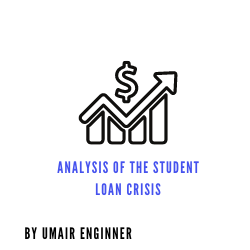Title: A Comprehensive Analysis of the Student Loan Crisis
Introduction
In the twenty-first century, student loans have become an
unavoidable reality for many people pursuing higher education. Students are
becoming more and more dependent on loans as the cost of attending college
rises. In addition to having an influence on borrowers' personal life, this
problem has broad economic and cultural ramifications. We will dig into the
nuances of the student debt dilemma in this essay, looking at its causes, effects,
and potential remedies.
The Crisis in Student Loans' Root Causes
We must first look at the causes of the student debt issue
in order to comprehend it. There are several influencing elements, such as:
Rising tuition costs: Over the past two decades, college
tuition has increased dramatically, exceeding inflation and income growth. As a
result, many students now find it more difficult to afford higher education and
must rely on loans to do so.
money shift: Public support for higher education has declined,
while the proportion of money coming from student fees has grown. Students and
their families are now bearing a heavier financial load as a result of this.
Predatory lending practices: Some for-profit universities
and private lenders have used predatory lending techniques, focusing on
providing loans with high interest rates and unfavorable terms to vulnerable
students.
The Crisis's Repercussions
The student debt problem has far-reaching effects on the
economy and society as a whole as well as on individual borrowers. The
following are a few of the most prominent effects:
Borrowers are under financial hardship because of their debt
loads, which make it harder for them to become financially stable. Milestones
like getting married, owning a home, and beginning a family have been postponed
as a result.
influence on mental health: The strain of paying off student
loans can have a negative influence on borrowers' mental health, resulting in
anxiety, depression, and other problems.
Consequences for the economy: Because borrowers have less
discretionary income to spend on goods and services, high levels of student
loan debt might impede economic growth. This can therefore result in decreased
consumer demand and company investment levels.
Social inequality: Minority and low-income students have
been disproportionately impacted by the student loan crisis, aggravating
already-existing social and economic inequalities.
Potential remedies
A holistic strategy that tackles the underlying issues and provides
borrowers with relief is needed to address the student loan crisis. Potential
remedies include the following:
Increasing public funding in higher education might lower
tuition prices and make college more affordable for a wider spectrum of students.
Adopt income-driven repayment strategies: Income-driven
repayment strategies link borrowers' monthly loan payments to their take-home
pay, ensuring that payments are affordable no matter what their financial
status.
Offer loan forgiveness programmers. These initiatives can
help those who make significant contributions to society—such as those who work
in the public sector or in underserved areas—by easing the burden of their
student loan debt.
Predatory lending practices should be regulated. Tighter rules
for private lenders and for-profit universities can shield students against
predatory loan practices.
Encourage students to be financially literate by teaching
them about budgeting and appropriate borrowing so they can make better choices
about how to pay for their education.
Encourage non-traditional educational paths: Opening up
options for apprenticeships, vocational training, and other non-traditional
educational routes can assist to lessen the need for student debt while still
giving people access to vital chances and prospects.
Conclusion
The student debt crisis is a complicated problem with
underlying roots and wide-ranging effects. It will need a coordinated effort
from decision-makers, educational institutions, and individuals to address this
situation. By investigating and putting up viable solutions, we can move
towards a time where everyone has access to higher education without having to
worry about crushing debt.







0 Comments